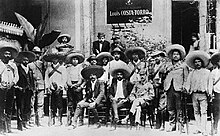
Zapatismo is the armed movement identified with the ideas of Emiliano Zapata, one of the leaders of the Mexican Revolution, reflected mainly in the Plan of Ayala (1911). The members of the Liberation Army of the South led by Zapata were known as "Zapatistas". Zapatismo is a form of agrarian socialism.
Philosophy
Zapatismo is primarily concerned with land reform and land redistribution according to the Plan of Ayala and the Agrarian Law written in 1915, signed by Manuel Palafox. Such documents confirmed the right of the citizen to be able to possess and cultivate the land, that lands were to be fairly returned to indigenous peasant farmers, villages were to retain the right to maintain ejidos. This was a direct response to the encroachment faced during the Porfiriato. The Zapatistas and many rural peasants opposed Porfirio Díaz's efforts at land privatization of previously communal lands because the small plots hindered the ability to plant enough maize and staple crops to survive the year. Zapatismo called for a broader better system in which land claims can be processed and collective lands can be returned to their respective communities.
The motto of Zapatismo "Liberty, Justice, and Law," later altered to "Reform, Liberty, Justice, and Law," is believed to have been borrowed, if not heavily influenced by Ricardo Flores Magón's anarchist newspaper Regeneración. It reflected the popular phrase used by the Mexican Liberal Party, "Tierra y Libertad," in English, "Land and Liberty."

Zapatismo is also associated with banditry. It was a common tactic for Zapatista forces to ransack the wealthy land-owning elite in Mexico. Banditry within troops would become an increasing problem, something that Francisco I. Madero would call out and use as a slight against Zapata and Zapatismo as a whole. Fearing the ramifications of having a reputation as a bandit, Zapata would attempt to enforce rules barring troops from looting the poor.
Mexican Revolution
The ideals of Zapatismo spread throughout Mexico during the Mexican Revolution, but the army was localized in the state of Morelos and subsequently, Zapatismo ideals were mostly practiced and enforced just in the state of Morelos. The ideals of Zapatismo were mocked and frowned upon by Francisco I. Madero, who gave permission for the Plan of Ayala to be published so that, "everyone will know how crazy that Zapata is." Zapatismo clashed with the ideologies of Venustiano Carranza and Francisco I. Madero because it was antithetical to the idea that the Mexican Revolution was the creation of the urban working class.
Zapatismo would have an influence on the 1917 Mexican Constitution due to the sheer number of radical delegates at the Constitutional Convention of Querétaro. Article 27 in particular would accomplish one of the many goals of Zapatismo. It mandated the return of the lands that were privatized and taken under the control of Porfirio Díaz. It also stated that land can be taken away if it wasn't put to good use and be given to the public instead. Article 123 included labor rights for all workers, child labor laws, and laws protecting women in the workplace.
After Emiliano Zapata's Assassination

Zapatismo continued after the assassination of Emiliano Zapata in 1919. Many of the remaining Zapatistas continued to fight Venustiano Carranza's forces, others surrendered peacefully in exchange for amnesties. In 1920, Álvaro Obregón sided with the Zapatistas in a coup against Venustiano Carranza's government. This led to the installation of agrarian reforms in the state of Morelos.
Emiliano Zapata became a national hero after his death. The face of Emiliano Zapata became representative of Zapatismo as a whole and his image would be called upon whenever land reform was brought to the table.
After Mexico signed the North American Free Trade Agreement, the Zapatista Army of National Liberation (EZLN) would declare war on the Mexican government. Their ideology (Neozapatismo) would be similar to the original Zapatismo of the Mexican Revolution but includes additional feminist and anti-neoliberal sentiments.
See also
- Agrarianism
- Agrarian Socialism
- Economic history of Mexico
- Index of Mexico-related articles
- Mexican Revolution
- Neozapatismo
- Plan of Ayala
References
- ^ Womack, John (1970). Zapata and the Mexican Revolution. A Vintage book, V-627. New York: Vintage Books. ISBN 978-0-394-70853-9.
- Craib, Raymond B. (2004-11-01), Cartographic Mexico: A History of State Fixations and Fugitive Landscapes, Duke University Press, ISBN 978-0-8223-8594-3
- ^ Brunk, Samuel (1996). ""The Sad Situation of Civilians and Soldiers": The Banditry of Zapatismo in the Mexican Revolution". The American Historical Review. 101 (2): 331–353. doi:10.2307/2170394. ISSN 0002-8762. JSTOR 2170394.
- Garza, Hisauro A. (Summer 1979). "Political Economy and Change: The Zapatista Agrarian Revolutionary Movement". Rural Sociology. 44 (2): 281–306 – via EBSCO.
- Oficial, Diario. "The Constitution of 1917 - The Mexican Revolution and the United States | Exhibitions - Library of Congress". www.loc.gov. Retrieved 2024-05-02.
- Russell, Phillip (2011). The History of Mexico: From Pre-Conquest to Present. Routledge.
- "The Zapatista Movement: The Fight for Indigenous Rights in Mexico". Australian Institute of International Affairs. Retrieved 2024-04-29.
| Zapatista Army of National Liberation (EZLN) | |
|---|---|
| Governance | |
| History | |
| Media | |
| People | |
| Related topics | |